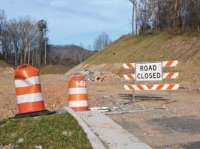Raleigh comes to Sylva in support of historic tax credit bill
 If traffic seemed a bit slow through downtown Sylva on Friday (May 22), it probably had something to do with Gov. Pat McCrory’s afternoon stroll along Main Street that day.
If traffic seemed a bit slow through downtown Sylva on Friday (May 22), it probably had something to do with Gov. Pat McCrory’s afternoon stroll along Main Street that day.
He — as well as a group of local decision-makers including Sen. Jim Davis, R-Franklin, members of the town board and county commissioners and local government administrators — joined Susan Kluttz, Secretary of the N.C. Department of Cultural Resources, on her 68th stop in a statewide tour espousing the pros of renewing North Carolina’s historic tax credit.
“Isn’t it beautiful? This is Americana right here,” McCrory said as he walked through the sunny downtown.
The group walked down the 107 steps of the Jackson County Library, along Main Street and then back up Mill, touring a district that landed a spot on the National Register of Historic Places last fall. Sylva’s downtown is officially a historic district, and if the historic tax credit is reinstituted as McCrory hopes, more than 40 buildings there could benefit.
North Carolina’s historic tax credit program began in 1998, giving credits of 20 to 30 percent to more than 2,400 projects. Those projects brought in more than $1.67 billion of private investment until the program expired at the end of 2014, according to statistics kept by the state.
Proponents of the program say it’s a way to revitalize communities and preserve heritage — and that it pays for itself through increased property values, tourism and economic development — but the program has its critics, too, mainly a contingent of Republican legislators who see tax credits as unfairly favoring some people over others.
Related Items
“The present Legislature is trying to get out of the business of picking the winners and the losers and getting out of the business of tax credits and getting the rates down,” explained Davis.
In an attempt to quell those concerns, McCrory’s proposal reduced the tax credits — which had formerly been worth 20 to 30 percent — to 10 to 15 percent and capped the amount of investment that would be eligible for them. Only properties actually listed on the National Register of Historic Places could receive the credits, and property owners could receive the credit only after the project was complete.
Davis is “probably more favorable than some” to the tax credit, but he has his reservations. He’d like to see the tax credit manifest as a partnership between state and local government, with local government giving some kind of tax break on its end as well. But he expects that it would be a long shot for the bill, as approved by the House, to find favor in the Senate.
“I don’t know if it’s going to survive in the Senate,” he said. “It’s going to be a heavy lift.”
Rep. Joe Sam Queen, R-Waynesville, signed on as a sponsor of the House version — which passed 98-15 — and hopes the bill will make it to the finish line.
“The historic tax credits are very important,” he said. “I worked hard to restore them. It was crazy to eliminate them to start with.”
Kluttz thinks they need to come back, too. Once the tax credits sunsetted, she embarked on a statewide tour to make sure communities in North Carolina understand just how the historic tax credit can benefit them.
“The historic properties in between [the mountains and the coast], every one of them is just as important because that tells the North Carolina story,” she said. “If you only let that [historic preservation] be done in communities that can afford it, you don’t tell the entire story.”
Aside from the downtown district in Sylva, there are 19 such properties in Jackson County. In Haywood County, there are 23 historic properties and one historic district — Frog Level. Swain has eight properties and one archeological district, and Macon has 20 historic properties and two historic districts — Highlands North Historic District and West’s Mill Historic District.
The tax credits are a good way to spur private investment in the state in a way that celebrates North Carolina’s heritage while also growing the value of its communities, McCrory said.
“It’s not free, but we get a return on investment, and I believe in investing in things which get you a return on investment,” he said.
The program has met positive reception from some local leaders.
“I think it’s a good thing,” said Jackson County Commission Chairman Brian McMahan. “There are several property owners that could use the tax credit to do some rehabilitation.”
“It would be an excellent thing for Sylva,” agreed Sylva Town Manager Paige Dowling.
But it’s hard to say whether the bill now sitting in the Senate’s Committee on Ways and Means will ever become law. Time will tell.









